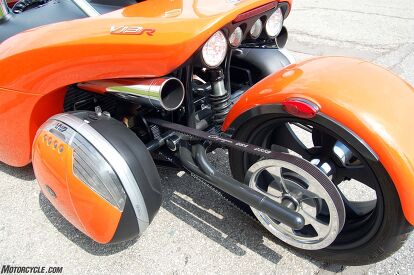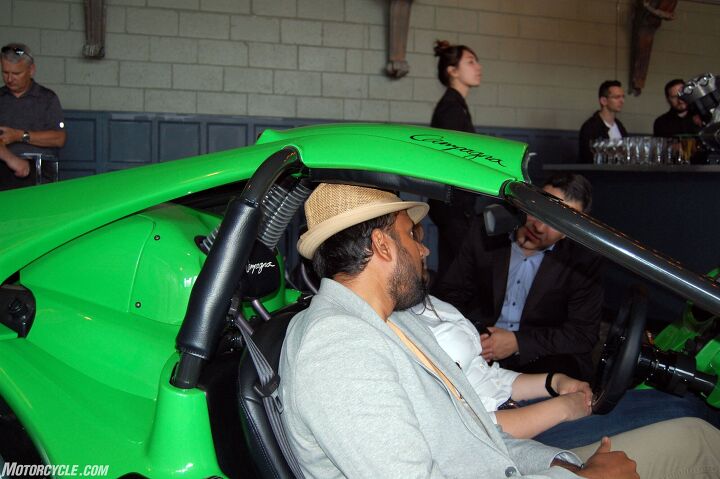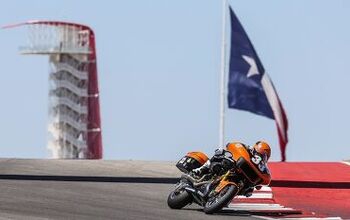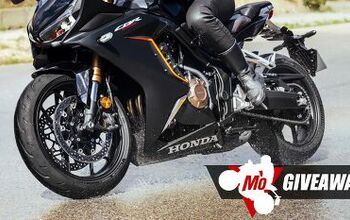Campagna T-Rex 16S and V13R First Impressions

If California is the land of motorcycles and Detroit’s the automotive capital, then Quebec must be Mecca for three-wheelers. Maybe there’s an inherent character trait in Quebec, a province that has carved out a French-speaking culture in a predominantly English-speaking continent, that leads some to want a similar niche for three-wheeled vehicles where four is the norm.
It is, after all, in la belle province where Bombardier calls home and has been producing Can-Am Spyders since 2007. But Quebec’s three-wheeler heritage continues back to 1988 when Daniel Campagna, former lead mechanic to Formula 1 legend Gilles Villeneuve when he raced snowmobiles, dreamed up the Concept 3. That prototype eventually evolved to become the T-Rex, entering production in 1995, with the roadster-styled V13R joining it in 2011.
Campagna entered the U.S. market in 2001, gaining CARB approval for California the following year. Today, Campagna says 45% of all its sales have come from the U.S. while Quebec still accounts for 40% of all models sold. Not all of Canada, just Quebec, a single province with a population of 8.2 million, just a smidge smaller than New York City. The fact is, Campagna’s sales in the rest of its native country are negligible, despite getting national certification from Transport Canada in 2006.
The reason? As Polaris learned first-hand in Texas with the Slingshot, vehicle regulations vary among states and provinces, with many jurisdictions lacking adequate laws for registering three-wheeled vehicles like the T-Rex. Transport Canada may have made the T-Rex street legal across the country, but it was up to the provinces to issue license plates. That’s taking a while as lawmakers figure out how to categorize something that’s neither a car nor a motorcycle, and yet a little bit of both.
Engine Evolution
The first production T-Rexes were equipped with Suzuki GSX-R1100 engines, with Campagna buying complete bikes and harvesting the motors. Over the next two decades, Campagna went through several different powertrains in search of improved performance as well as steady supply. In 1999, the T-Rex switched to a Kawasaki ZX-11 engine, adding a ram-air intake to the roll cage above the seats. When Kawasaki replaced it with the ZX-12R in 2000, Campagna followed suit a few years later.
Excluding a limited run of 10 vehicles in 2003 that used S&S V-Twins, Campagna stuck to Kawasaki engines for several years, replacing the 1200cc engine with the ZX-14’s powerplant in 2007.
A year later, Campagna was purchased by Cirbin Motors, another Quebec company that built three-wheelers. The acquisition merged the two brands, with the Cirbin V13R adopting the Campagna brand. Cirbin had an engine supply agreement with Harley-Davidson for the V-Rod Revolution, receiving whole powertrains from Milwaukee. This provided a steadier and more efficient source of engines than relying on buying whole bikes.
In 2013, Campagna signed a deal with BMW, securing a supply of six-cylinder K1600 engines that now power current T-Rexes. BMW provided support by sending engineers to Quebec to help Campagna integrate electronically selectable ride modes and also supplying the K1600’s digital instrument panel. The engine supply agreement runs through 2018 with an option to renew every five years.
Naturally, few were as excited as the folks at Campagna when the government of Ontario, announced a 10-year pilot project to permit three-wheeled vehicles such as the T-Rex and the Polaris Slingshot in Canada’s most populous province. Under the pilot project, three-wheelers will be registered as motorcycles; however, operators only require an automobile driver’s license. Both helmets and seatbelts must be worn by both drivers and passengers.
We got a chance to ride both the T-Rex and V13R during its Ontario launch in Toronto. Unfortunately, we didn’t get much time behind the wheel, as Campagna only had one of each available and a full slate of auto- and moto-journalists lining up to drive the three-wheelers. We’re hoping to get a couple of vehicles out to California for a longer test and perhaps see how it stacks up against the Polaris Slingshot.
Polaris Slingshot vs. Can-Am Spyder F3-S vs. Morgan 3 Wheeler
The T-Rex 16S and the V13R have much in common but offer two distinctly different experiences share. They both have a “tadpole” style architecture with two wheels at the front to steer and a third wheel providing propulsion at the rear. Both are powered by motorcycle engines, a BMW-supplied six-cylinder K1600 engine for the T-Rex while the V13R uses a V-Rod Revolution engine from Harley-Davidson. The seating positions for the two vehicles are so low, Campagna executives joke about being able to file your nails just by reaching out of the cockpit and dragging them on the ground. But the two three-wheelers come from two different evolutionary paths. The V13R was originally produced by a separate company called Cirbin Motors. Cirbin owners André Morrisette and David Neault bought out Campagna when it went through some financial difficulties in 2008, rebranding their V13R as a Campagna.
The Savage Beast
Getting into a T-Rex takes considerable coordination, especially for those long in limb. There are no doors, so you have to learn to lean on the side, pivot your legs over and slide them in together before shifting your weight entirely on the seat. Removing the steering wheel helps makes things easier. Like detaching a lens from a DSLR camera, you simply press the button on the retaining ring, then rotate until it uncouples. The process is easier on some body types, but I was able to figure out how to get my six-foot-tall heavyset frame in and out quickly after just a few attempts.
Once inside the cockpit, it’ll take a moment to get used to the seating. The T-Rex is only 42 inches tall at its highest point and the seats are just inches from the ground. We often joke about cruiser riders positioned like they’re sitting in recliners; with a T-Rex that’s no joke as the seat tilts your torso back and your legs are nearly horizontal in front of you. The seat back is adjustable, as are the pedals, both sliding backwards or forwards along a metal tube and held in place by a retaining pin.
You would think this reclined seating position would free up more headroom, but I still found my head uncomfortably close to the roll cage and its integrated air intake. And that’s before I put on my full-faced helmet which forced me to drive with my head tilted slightly to the left, making it difficult to check the passenger-side mirror. Campagna recommends drivers wear half-helmets but those living in areas where you don’t need a helmet to drive a three-wheeler will appreciate the extra headroom.
The cockpit is designed to seat two, as long as you don’t mind sitting shoulder to shoulder. Considering the T-Rex has a claimed curb weight of just 1,100 pounds, adding a passenger (especially a larger one) can affect the driving dynamics, but unlike a motorcycle, the weight is distributed sideways and shared between the two front wheels.
Pressing the ignition, the BMW 1649cc inline-Six rumbles to life before settling into a happy idle. Motorcyclists are more familiar with hearing loud engine noises than car drivers are, but it was a bit disconcerting hearing it come from a couple of feet behind my head instead of between my legs.
Campagna didn’t change much in the engine. It still claims a peak output of 160 hp at 7750 rpm and 129 lb-ft. at 5250 rpm. The T-Rex offers three selectable ride modes: Rain, Road and Dynamic. As with the K1600, Rain limits the power output while Road and Dynamic differ in throttle response.
The gearbox is also mostly unchanged, albeit with a hand lever sequentially shifting the gears in a 1-N-2-3-4-5-6 pattern. Shifting gears in the T-Rex works more like a motorcycle than a typical manual transmission car; the only difference is you use your hand to work the shifter and your feet to manipulate the clutch and throttle. The clutch pedal doesn’t offer the same fine control a motorcycle clutch lever provides, so it takes some practice to get a feel for the friction point. I stalled several times driving both the T-Rex and the V13R while starting from a dead stop
The only modification to the gearbox Campagna made is adding a reverse gear so the T-Rex could maneuver in and out of parking spaces. The K16’s predecessor, the K1200LT, had reverse, powered by the starter motor, but Campagna has its own custom electronically-controlled mechanical system. Given how much support BMW provided Campagna with their engine supply deal, it’ll be curious to see if this reverse gear system could go the other way and end up on a future K1600GTL.
Our test ride took place on the streets just outside Toronto’s Pearson International Airport which offered several long, straight six-lane roads which provided ample space to test the T-Rex’s incredible acceleration. Campagna claims an impressive 0-60 time of 3.9 seconds, but doing so at such a low seat height pushes impressive to near-terrifying, especially when you pull alongside an 18-wheeler and realize the tires are at eye level. When accelerating that quickly on a motorcycle, you’re usually leaning forward over the tank. In the T-Rex, the acceleration pushes you even further back in the seat and it feels more like riding a roller coaster than a street-legal vehicle.
While the T-Rex accelerates like a motorcycle, it certainly brakes like a car. The Wilwood four-piston calipers provide good bite to the front wheels, and deceleration doesn’t feel any different than in an automobile. The lack of ABS is a bit surprising, as it’s legally mandated on passenger cars in the U.S., as is electronic stability control. Since the Campagnas are not considered cars, they are exempt and have neither ABS or ESC.
The T-Rex uses a rack-and-pinion steering system with no power assist, but turning the wheel feels effortless and the T-Rex handles well with strong feedback from its mechanical steering. The light weight and low center of gravity certainly help in that regard.
What it doesn’t help is dealing with bumps and curbs. There is an odd fascination in watching the coilover shocks bounce with every road imperfection from just an arm’s length away. I just wish my tailbone didn’t feel every bump as well. Curbs are especially tricky, and it’s hard to turn onto a steep driveway without scraping the bottom of the T-Rex.
But that’s part of the trade-off for an unapologetically raw beast like the T-Rex with comfort taking a back seat to pure performance (which says something, because the T-Rex doesn’t have a back seat).
Not that there aren’t some creature comforts. The T-Rex comes standard with a 180-watt four-speaker Alpine sound system with Bluetooth, USB and audio line-in connectivity.
The version we tested was the standard T-Rex 16S (CA$57,999) with the optional red seats (CA$1,500) and a Travel Package (CA$2,299) which adds a passenger footrest, small deflector screen and a pair of and a pair of Givi cases (they’re actually motorcycle top cases, only mounted vertically alongside the engine). Without the cases, storage options are limited to a small space in front of your feet and a doorless glove compartment with built in 12-volt outlet.
If you’re willing to spend a bit more (and if you’re the kind of person who can afford a T-Rex, that’s entirely likely) there’s an up-spec T-Rex 16SP priced at CA$63,999. The SP adds fully-adjustable suspension, steel-braided brake lines, red calipers, a D-shaped steering wheel, and upgraded seats.
V13Roooooooom!
While the T-Rex puts a premium on performance, the V13R was designed to offer a hot-rod experience. The squarish front, projector-style headlights and front grille give off an art deco vibe.
Getting into the V13R is a little easier than the T-Rex because there’s no roll cage overhead. You just hop straight in and don’t have to worry about compromised headroom. It still gets cramped with two people on board however.
The Harley-Davidson V-Rod engine provides a different audio and tactile feeling than the T-Rex’s BMW I-6. The Porsche-designed Revolution is louder and the vibrations are felt throughout the cockpit.
Compared to the T-Rex, the V13R is more sedate, claiming 122 hp at 8,250 rpm and 84 lb-ft at 7,000 rpm. The V13R also weighs a bit more, coming in at a (claimed) 1,156 pounds, but the roadster still accelerates at a decent clip, claiming a 0-60 time of 5.6 seconds. The V13R delivers an exhilarating rush of acceleration, and the difference wouldn’t have been so pronounced if I hadn’t ridden them both back-to-back.
The transmissions offers five sequential gears plus reverse. While the T-Rex’s reverse gear is electronically activated with a button on the shift knob, the V13R uses a mechanical lever located in front of the stick.
After seeing the T-Rex’s BMW-supplied digital dash, the V13R’s analog instruments are disappointing. The analog instrument cluster may fit better with the V13R’s retro vibe, but the central mounting location and the small size made it difficult to see while driving.
We didn’t get as much time to drive the V13R as we did the T-Rex, but I did get to ride along with Campagna technical coordinator and racer Benoit Gillis-Gaumond. Gillis-Gaumond races a modified T-Rex and few know better how to push the Campagnas to their limits. Before long, we were weaving through traffic, driving slaloms across open lanes and sliding the fat P295/35ZR18 rear tire around corners.
The V13R retails for CA$53,999 but is available with a number of add-ons including a chrome kit, tan seat and travel package.
Three-wheeled toys
Make no mistake, these three-wheelers are not for everyone. The Campagna T-Rex 16S and V13R are raw, impractical, uncomfortable and sometimes downright terrifying. But they also offer an exhilarating experience rarely found in a street-legal vehicle and draw attention everywhere they go with their unique looks and sounds.
According to Campagna, the T-Rex is targeted for a primarily male demographic, ages 30-55 who want sportscar performance but like to stand out in a crowd. The V13R, meanwhile is aimed for a slightly older crowd, ages 45-60 and are attracted to the Harley-Davidson brand. It also helps to be in a tax bracket that can afford a $60,000 toy.

Dennis has been a part of the Motorcycle.com team since 2008, and through his tenure, has developed a firm grasp of industry trends, and a solid sense of what's to come. A bloodhound when it comes to tracking information on new motorcycles, if there's a new model on the horizon, you'll probably hear about it from him first.
More by Dennis Chung







































































Comments
Join the conversation
For that money I would want shaft drive. Why in the hell would anyone want to crawl under this thing to do chain maintenance? I admit they are pretty awesome..
You've got the REALLY want to stand out. For $60k you could buy a base Corvette, or a used version of a lot of far more practical sports cars. That's what I'd do.